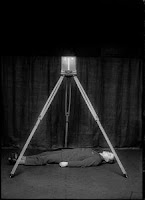Burden of Proof: The Construction of Visual Evidence
Fascinating exhibition at the Photographers’ Gallery looking at how photography and film
has been used as factual evidence in courtrooms.
It takes eleven
cases studies starting with the invention of metric photography of crime scenes
in the 19th century. This is a protocol for representing crime scenes using an
overhead camera on a tripod which takes an image of the whole body of the
victim as well as how it lies in its environment. These were grisly pictures
but drew you in.
It then looked at
Rodolphe Reiss who introduced the idea of taking close up pictures of evidence
which allows you to look in more detail at the object and often shows things
which can’t be seen by the naked eye. Reiss went on to be the first chair of
forensic science.
Most moving was a
series of pictures from the Great Terror in Russia from 1937-38 in which
750,000 were killed and 7000,000 were deported. These pictures were mug shots
taken against a neutral background of those who were found guilty, many of who
were executed shortly afterwards. These pictures are an awful democratic record
of these people which was supressed but has come to light again since and used
as evidence of this period of history. The pictures where shown rolling on a
big screen, showing the picture first then placing the person’s name, age,
occupation and ‘crime’ next to the picture. It gave you a chance to look at and
engage with the image before you knew more about it.
Also interesting
was a section about John Ford’s film of the concentration camps which was made
for and used at the Nuremberg trials. It showed not only how the film was made
but also how it was shown at the trail, illuminating the box where the accused
were sitting so their reactions could be seen.
The other case
studies were also really including the Gaza book of destruction which recorded
and documented the destruction caused by an Israeli attack in 2008 and the
effect of photographing the Turin Shroud. There was just too much interesting
stuff to write about!
Closes on 10
January 2016.
Review
Guardian



Comments